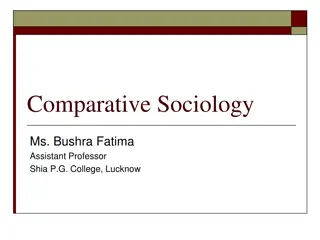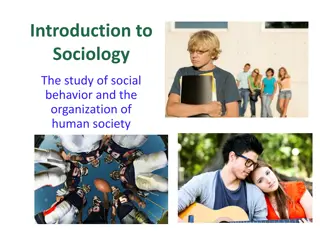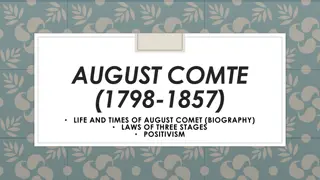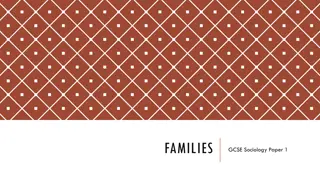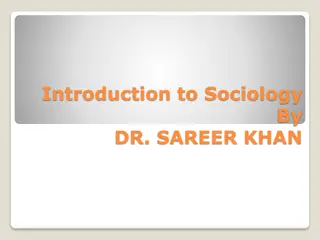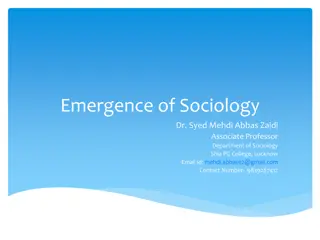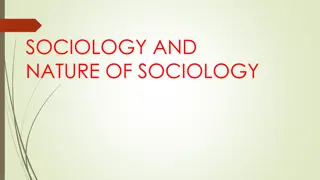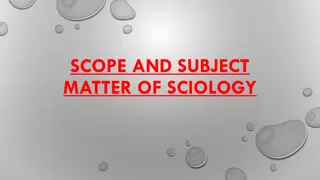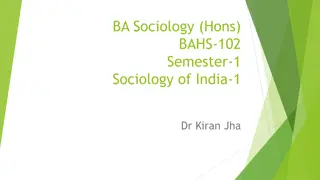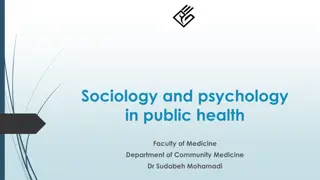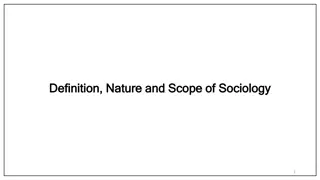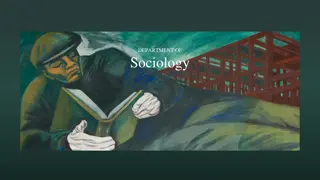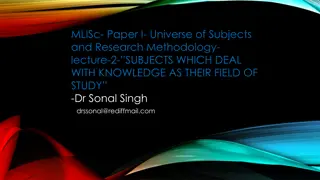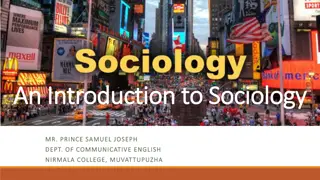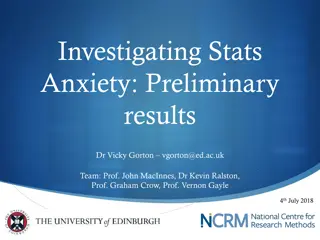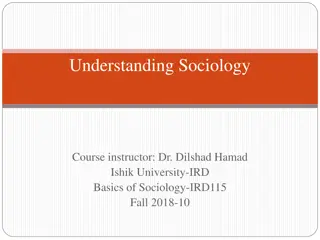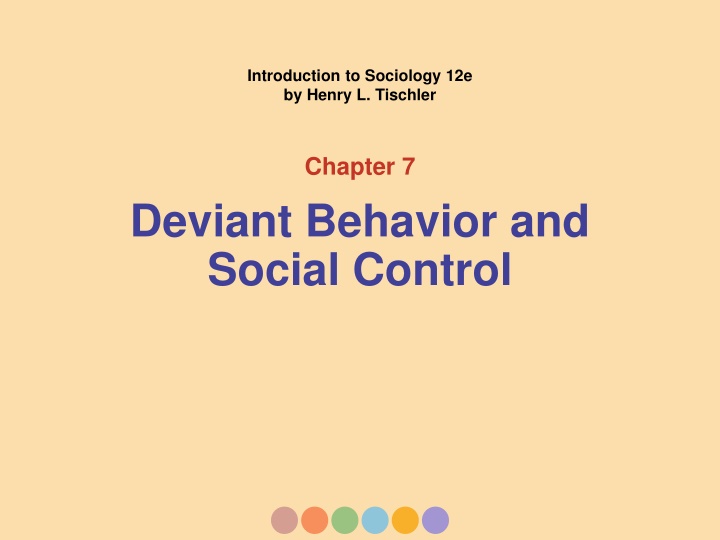
Deviant Behavior and Social Control in Sociology
Explore the cultural relativity of deviance, functions and dysfunctions of deviant behavior, internal and external means of social control, different types of sanctions, various theories of deviance, role of anomie, sources of crime information, features of the criminal justice system, and more in Chapter 7 of "Introduction to Sociology" by Henry L. Tischler.
Download Presentation

Please find below an Image/Link to download the presentation.
The content on the website is provided AS IS for your information and personal use only. It may not be sold, licensed, or shared on other websites without obtaining consent from the author. If you encounter any issues during the download, it is possible that the publisher has removed the file from their server.
You are allowed to download the files provided on this website for personal or commercial use, subject to the condition that they are used lawfully. All files are the property of their respective owners.
The content on the website is provided AS IS for your information and personal use only. It may not be sold, licensed, or shared on other websites without obtaining consent from the author.
E N D
Presentation Transcript
Introduction to Sociology 12e by Henry L. Tischler Chapter 7 Deviant Behavior and Social Control
Learning Objectives Understand deviance as culturally relative. Explain the functions and dysfunctions of deviance. Distinguish between internal and external means of social control. Differentiate among the various types of sanctions. Describe and critique biological, psychological and sociological theories of deviance. Discuss the concept of anomie and its role in producing deviance. Know how the Uniform Crime Reports and the National Crime Victimization Survey differ as sources of information about crime. Describe the major features of the criminal justice system in the United States.
Defining Behavior Normal behavior we most commonly expect to encounter Deviant behavior that fails to conform to the rules or norms of the group in question (Durkheim)
Source of Definitions Cultural expectations based on symbolic interpretation of: Good Bad Right Wrong
Functions of Deviance An integral part of all healthy societies Causes members to connect, close ranks Prompts members to organize against future deviance Clarifies beliefs and expectations of group Teaches norms by providing examples of deviance Acts as safety valve, inhibiting greater deviance ( mile Durkheim)
Dysfunctions of Deviance Threat to the social order Makes social life difficult and unpredictable Causes confusion about the norms and values of a society Undermines trust Consumes resources that must be shifted from other social needs
Control Mechanisms Internal means individual conformity as part of acceptance External means social rewards and punishments for failure to conform
External Means Sanctions Positive (rewards) Negative (penalties) Formal (public ritual, force of law) Informal (spontaneous, indirect) All used to regulate an individual s behavior
Theories of Crime and Deviance Biological theories of deviance Psychological theories of deviance Sociological theories of deviance
Biological Theories Cesare Lombroso Criminals are born as such Evolutionary throwback, instinct-driven Physiologically different head, face, hair E.A. Hooten / William H. Sheldon Deterioration of organism The mesomorph Generally disaccredited
Psychological Theories Explanation of adult deviant behavior Manifestation of early experiences Not product of later social or cultural factors Downplay biological factors / emphasis on conditioning Parenting and early childhood experiences Other earlier behavioral conditioning
Psychological Theories Psychoanalytic Freud Unconscious; irrational thoughts and feelings lead to deviant acts Behavioral Adjusted in response to rewards and punishments / favorable outcomes repeated Individual choice Wilson & Herstein Rational choice (punishment / benefit analysis) based on factors affecting people
Sociological Theories Anomie Durkheim Values and norms lose impact / cultural guidance void exists Strain Merton Lack of legitimate means to achieve financial success leads to deviance Control Hirschi Deviance is product of absence of social control / product of weak bonds to society
Sociological Theories Techniques of Neutralization 1. Denial of responsibility 2. Denying the injury 3. Denial of the victim 4. Condemnation of the authorities 5. Appealing to higher principles or authorities
Sociological Theories Cultural transmission theory Sutherland and Cressey Two components in which criminal behavior is learned 1. Criminal techniques (how to break into houses) 2. Criminal attitudes (rationalizations that justify criminal behavior)
Sociological Theories Labeling theory Grounded in social process A person must be labeled as deviant Consequences of such labeling for the individual Labeling dependent upon: Importance of norms violated Identity of the potential deviance Social context of the behavior
Two Levels of Deviance Primary deviance the original behavior that leads to the application of the label to an individual Secondary deviance the behavior that people develop as a result of having been labeled as deviant
The Importance of Law Legal code The formal rules, called laws, adopted by a society s political authority The code is enforced through the use of formal negative sanctions when rules are broken
The Emergence of Laws Explanatory Approaches Consensus Conflict
The Emergence of Laws Consensus approach Formalized version of norms and values of society Conflict approach Elite use of power to support their own economic interests and go against the interests of the lower classes
Classification of Crime Felonies Offenses punishable by a year or more in state prison Misdemeanors Less serious offenses punishable by jail or a fine
Kinds of Crime in the United States Juvenile crime The breaking of criminal laws by individuals younger than age 18 Recidivism Repeated criminal behavior after punishment
Kinds of Crime in the United States Violent crime An unlawful event that may result in injury to a person Aggravated assault Rape Murder Robbery
Kinds of Crime in the United States Property crime An unlawful act that is committed with the intent of gaining property but that does not involve the use or threat of force against an individual Larceny Burglary Motor vehicle theft
Kinds of Crime in the United States White-collar crime Coined by Edwin J. Sutherland (1940) Refers to the acts of individuals who, while occupying positions of social responsibility or high prestige, break the law in the course of their work for the purpose of illegal personal or organizational gain
Kinds of Crime in the United States Victimless crime Violation of laws meant to enforce the moral code Personal use of narcotics Illegal gambling Public drunkenness The sale of sexual services Status offenses by minors
Kinds of Crime in the United States Victims of crime dependent variables Race Gender Age Socioeconomic status
Criminal Justice in the United States Provides personnel and procedures for arrest, trial, and punishment to deal with violations of the law Police Courts Prisons / Corrections
Goals of Imprisonment / Corrections Four primary roles / goals 1. Separate criminals from society 2. Punish criminal behavior 3. Deter criminal behavior 4. Rehabilitate criminals
Problems with Prisons / Corrections Shortage of prisons Overzealous establishment and enforcement of norms Budgetary constraints Female incarceration Family dependence problems; children as victims Funnel effect Underreporting; minimum sentencing


